1. IONS PUSHED TO ONE SIDE OF THE STALK
3. BOL'S IN VERTICAL MOTION - THE LORENTZ FORCE
4. BOL'S IN VERTICAL MOTION - PART 2
5. THE SUPERBOL AND ALTERNATING CURRENTS
13. MAGNETIC DUST SUCKED IN AND SPRAYED OUT
We start with a circlecurrent laying on the soil. Take for analysis a plane at the same distance above the circlecurrent, about 2 inches above the soil (horizontal black dashed line). The BoL moves upward (or the BoL doesn't move and the soil moves downward). Then the picture of the magnetic field (horizontal component only) has precisely the same deep blue arrows except for that the arrows now all point outward. The law of the Lorentz-force then gives:
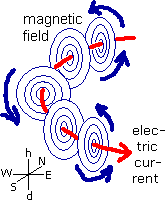
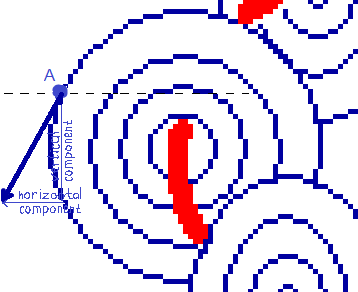
Fig. 3.1

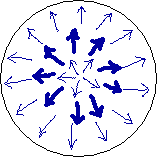
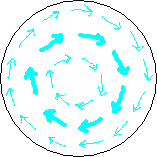
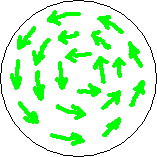
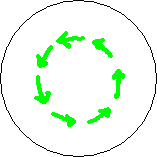

 Fig. 4.1
Fig. 4.1
red = electric currents and electric charges
green = crop
light blue = force
E = electric
deep blue = magnets and magnetic field
brown = soil
grey = velocity
M = magnetic
This means the effect of the two planes of analysis so far, one just under the circlecurrent and the other the same distance above it, will tend to cancel each other out. When the BoL raises a specific ion in the stalk would experience subsequently a push towards one side of the stalk from the upper half of the BoL and then an equal push to the opposite side of the stalk from the lower half of the BoL. These pushes will undo each other, resulting in no change of the ion density and so no cropcircle forming, maybe there is some heating. Should we retract our celebration cards from sending them around?
Let's have a closer look at e.g. the first few inches above the soil (black dotted line) when there appears and subsequently rises a BoL, see fig. 4.2.

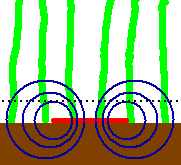 A
A  B
B 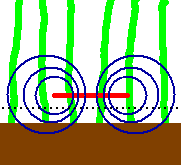 C
C 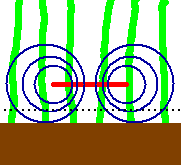 D
D
Fig. 4.2
A. On the bare soil between the stalks (green vertical structures) suddenly a circlecurrent appears (red line) just as if it is laid there on the ground - a BoL is born! (a proposal how this works is offered further on this storyline.) At the very first moment the BoL doesn't move and so its magnetic field, no matter how strong it is, will render no effect on still ions in the stalk. The black dotted line is about 2 inches above the soil.
B. Then all of a sudden the BoL shoots up to the sky. Now its magnetic field does do something. Depicted here is when the BoL has raised about 2 inches (5 cm) above the ground. The circlecurrent now is 2 inches above the ground. In the first 2 inches above the soil strongest horizontal field component is found directly below the circlecurrent and is weaker elsewhere. The ions in the stalks at 2 inches height have undergone the influence of the lowest 2 inches of the upper half of the BoL.
C. The circlecurrent has moved from the soil to about 4 inches above it. On the ions in the stalks at 2 inches above the soil now also the most upper 2 inches of the lower half of the BoL have had its influence. Provided the magnetic field strength and the velocity don't change in these first 4 inches of rising, the forces in our plane of analysis cancel each other out precisely. In our plane of analysis, 2 inches above the soil, no net ion separation is achieved yet when the BoL rises from the soil up to 4 inches. And thus no bending as effect of this, maybe some heating only.
D. The BoL rises higher. The part of the magnetic field below 2 inches under the circlecurrent now works on the ions in the stalks at 2 inches above the soil without ever having been affected by the corresponding part of the upper half of the BoL. The upper half above 2 inches above the circlecurrent will never have reached the part of the stalks at 2 inches above the ground. This conveys a push to the ions there to one side of the stalks that is not opposed by forces on an earlier or later time. Finally the stalk experiences a net asymmetric growpuls at the lowest part of the stalk only. Precisely what we need to make a tidy, neat cropcircle.
As you can see, when shifting from B to C to D the circle where the magnetic field is entirely horizontal (inducing maximum force) shifts a little to the outside (the circle of entirely horizontal field becomes larger). As you can see, at the same time the magnetic field line density there becomes lower, indicating weaker field. When the induced ion concentration drops below the threshold, no grow will start. The lay of the crop ends there, leaving the rest of the crop field unchanged.
Ever higher planes of analysis (when the dotted line is at 10, 20, 30, etc. inches above the soil) will have an ever larger part of the BoL above and below the circlecurrent that will cancel each other out. Leaving an ever weaker part of the field creating a net ion shifting to one side of the stalk. At higher distance above the ground the chance of bending is smaller while simultaneously the amount of heating mounts.
A similar picture holds for a descending BoL, coming in from above the crop and heading for the soil. Ion after ion in the upper parts of the stalks experience first the influence of the lower half of the BoL's magnetic field and then the influence of the upper part, canceling each other out, making bending in the more upper parts of the stalks unlikely. The heat involved with such a to-and-fro shaking just builds up. Now look at the lowest parts of the stalk, a plane at e.g. 2 inches above the ground. The entire lower half of the magnetic field of the BoL passes that plane causing a push on the ions to one side of the stalk there. Then the strongest part of the upper half of the magnetic field, the 2 inches of field just above the circlecurrent, work on the first 2 inches of stalks above the ground. This exerts a push on the ions in the stalks to one side of the stalk, in doing so counteracting and annihilating the previous push on the same ions to the other side of the stalk. Then the circlecurrent hits the ground and end its life there and the magnetic field ceases to exist. So the upper part of the magnetic field above 2 inches above the circlecurrent will never get its chance to undo the push that already has been given by the lower part of the magnetic field below the 2 inches under the circlecurrent.
So we found a way to make a cropcircle with magnetic fields from a circlecurrent, then found a serious flaw but finally solved it to end with precisely the result we want. That's really nice but I wonder how much I still have overlooked. There must be so much details that can cause extra different results. E.g. reaction time of the ions in the stalk; when the lowest part of the stalk already bents before the BoL could pass the upper parts, the upper parts of the stalk will be more horizontal when the BoL's magnetic field passes them. The ion concentration could be more downward (or upward) along the stalk instead of to one side of it. This will especially be the case when actual situation lets describe itself best with a sequence of 2 or 3 (more or less) identical BoL's rising from the soil one after the other.
Another example. In the center of the circlecurrent the magnetic field is strong (high field line density) but it is mainly vertical field component there and nearly no horizontal component. So when the BoL shoots upward the central part might get too little force and maybe is not downed. Depending on the size of the standing central part one speaks of a cropcircle with a central tuft
or of a cropcircle in the shape of a ring
. Which both is observed.
I strongly recommend a computer simulation of ions in stalks embedded in the BoL's magnetic field. However, this will incorporate all occuring effects only when you put in the simulation all basic effects like the Earthcurrent (chapter 8 and 9) and electricity conducting magnetic dust (chapter 10). Another way is computations with formula's, but that is more difficult, you have to be sure the formulas cover all occuring phenomena. And I whished there were experiments leading to results so we could distinguish what actually works and what doesn't. Page 7 of this storyline is about experiments.